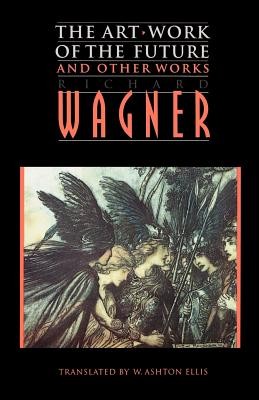
- We will send in 10–14 business days.
- Author: Richard Wagner
- Publisher: University of Nebraska Press
- ISBN-10: 0803297521
- ISBN-13: 9780803297524
- Format: 13.9 x 21.6 x 2.7 cm, softcover
- Language: English
- SAVE -10% with code: EXTRA
Reviews
Description
Poor, frustrated, and angered by the "fashion-mongers and mode-purveyors" of art, Richard Wagner published The Art-Work of the Future in 1849. It marked a turning point in his life: an appraisal of the revolutionary passions of mid-century Europe, his farewell to symphonic music, and his vision of the music to come. Beethoven's Ninth Symphony was unsurpassable, he wrote. Henceforth The Folk must of necessity be the Artist of the Future, and only artists who were in harmony with the Folk could know what harmony was for. The essay became a touchstone for Wagner, his family, friends, and followers, as he sought to produce works that thoroughly combined music, dance, drama, and national saga. In addition to Wagner's epoch-defining essay, this volume includes his Autobiographical Sketch, Art and Climate; his libretto for an opera, Wieland the Smith; and his notorious Art and Revolution. The concluding piece, A Communication to My Friends (1851), explains his views on his first successes--The Flying Dutchman, Lohengrin, and Tannhäuser--and defines his agenda for later works. As spokesman for the future, Wagner spoke most of himself. In these works he set forth his ambitions, identified his enemies, and began a campaign for public attention that made him a legend in his own time and in ours.
EXTRA 10 % discount with code: EXTRA
The promotion ends in 15d.01:12:16
The discount code is valid when purchasing from 10 €. Discounts do not stack.
- Author: Richard Wagner
- Publisher: University of Nebraska Press
- ISBN-10: 0803297521
- ISBN-13: 9780803297524
- Format: 13.9 x 21.6 x 2.7 cm, softcover
- Language: English English
Poor, frustrated, and angered by the "fashion-mongers and mode-purveyors" of art, Richard Wagner published The Art-Work of the Future in 1849. It marked a turning point in his life: an appraisal of the revolutionary passions of mid-century Europe, his farewell to symphonic music, and his vision of the music to come. Beethoven's Ninth Symphony was unsurpassable, he wrote. Henceforth The Folk must of necessity be the Artist of the Future, and only artists who were in harmony with the Folk could know what harmony was for. The essay became a touchstone for Wagner, his family, friends, and followers, as he sought to produce works that thoroughly combined music, dance, drama, and national saga. In addition to Wagner's epoch-defining essay, this volume includes his Autobiographical Sketch, Art and Climate; his libretto for an opera, Wieland the Smith; and his notorious Art and Revolution. The concluding piece, A Communication to My Friends (1851), explains his views on his first successes--The Flying Dutchman, Lohengrin, and Tannhäuser--and defines his agenda for later works. As spokesman for the future, Wagner spoke most of himself. In these works he set forth his ambitions, identified his enemies, and began a campaign for public attention that made him a legend in his own time and in ours.


Reviews